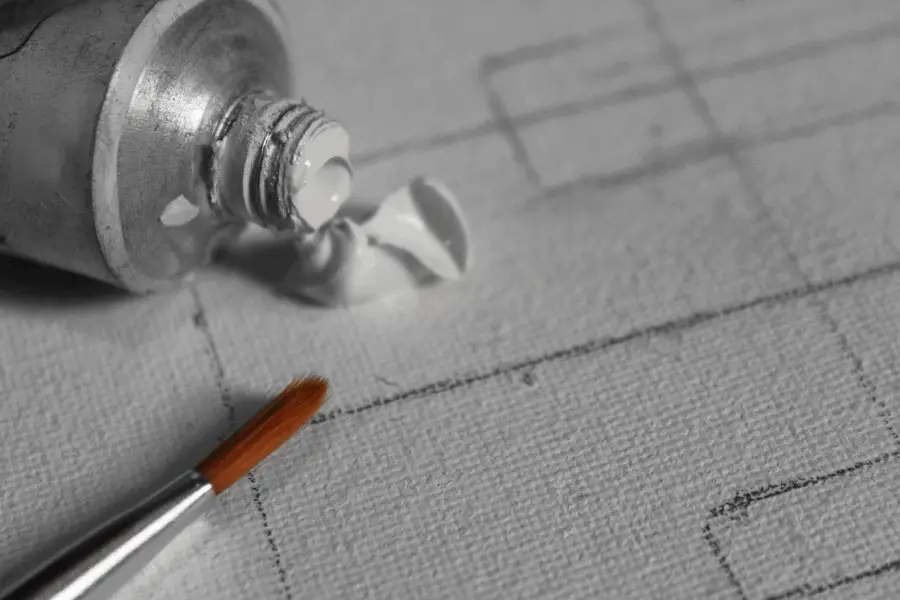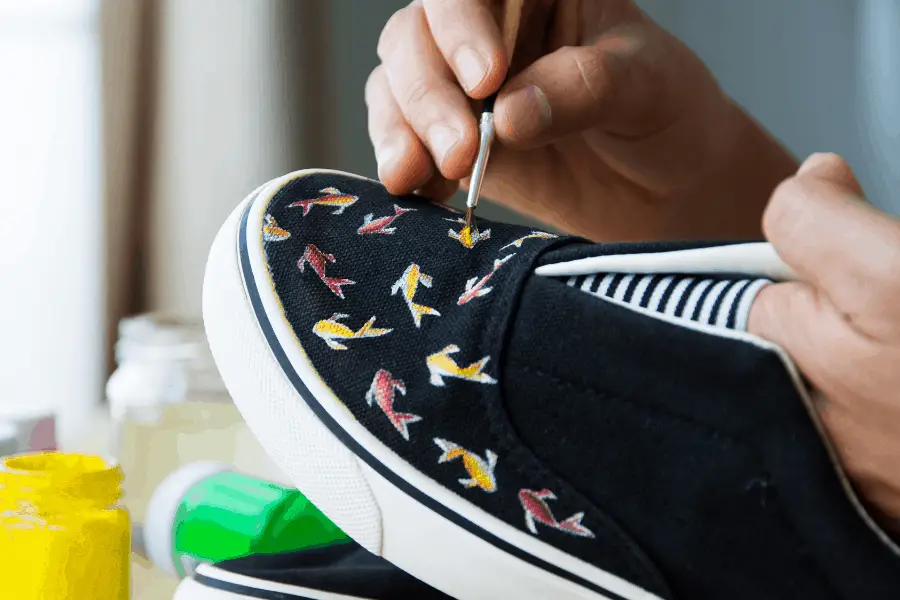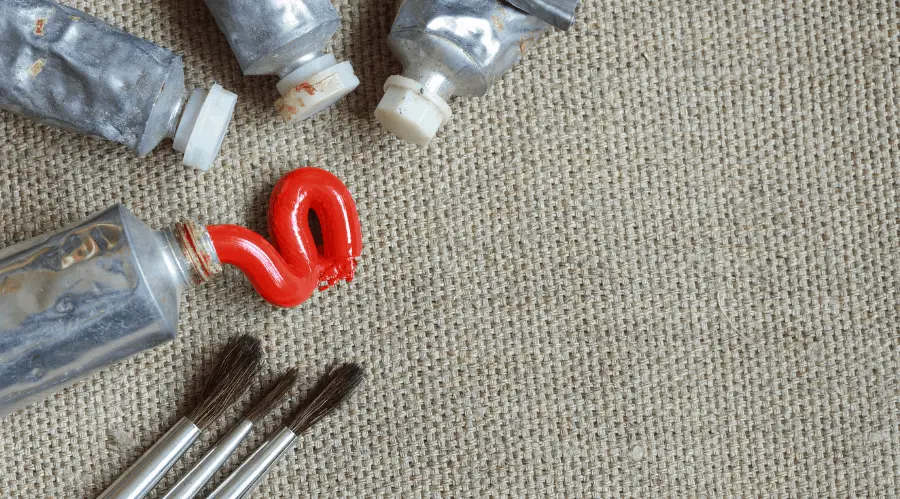Choosing the right type of paint to use on fabric can be a little tricky. Because of its more porous and flexible nature, it’s much more difficult to find the right paint for it than it is for other objects, such as stone, wood, or paper. Although fabric paint certainly is the best choice for painting on fabric, you can paint on fabric with other paint types, such as oil paint.
So, can you use oil paint on fabric? Definitely! In fact, oil paint has been used on fabrics for centuries. As a result, many artists opt for oil paints when painting on fabric, especially fabric canvases. Still, you can’t just put oil paint directly on the fabric, or else you could damage it. To find out exactly how to use oil paint on fabrics, keep reading.
Using Oil Paint On Fabric
Beginning in the Renaissance era, oil paint has been a favorite for artists wanting to paint on fabric canvases. In the 1500s, Renaissance painters would specifically use oil paint on fabric canvases, which were stretched over bars.
Today, artists still like to oil paint on canvas and fabric because of the superior blending abilities and the color quality.
My favorite and top pick is always Arteza Oil Paints. They have so many different colors, and the quality is amazing! I usually use Arteza Paints for all my projects.

Priming Is A Must
Whenever artists use oil paint on fabric, they have to put in a bit more effort to preserve the paint and fabric itself. If you put oil paint directly on the fabric, the paint will eat away at the fabric over time. As a result, priming the fabric is an absolute must if you want to use oil paint on fabrics.
The best priming method involves acrylic gesso. If you are using oil paintings on a fabric canvas, you need to apply two layers of the acrylic gesso before painting.
Even if you are only painting a T-shirt or some other fabric, you need to prime that as well. Apply at least one layer of white or clear gesso on that fabric.
This Mont Marte Primer is the one I use on all my fabric projects. It’s universal so it also works with acrylics, and gouache. I highly recommend this primer if you plan on using oil on fabric.
The Paint May Chip or Crack

Even if you prime your fabric before painting it with oil paints, know that oil paints come with some drawbacks on fabrics. Most notably, oil paint can become brittle and crack, especially on fabrics that you bend a lot.
For example, using oil paint on a T-shirt may not be the best option because the paint will crack and become damaged every time you wear the shirt or wash it.
If you really want to paint a t-shirt or other clothing items, this Arteza Fabric paint is a great alternative.
As for fabric canvases, you can seal the oil paint on the fabric, helping it to retain its beauty and color for longer. You can technically seal an oil-painted T-shirt as well, but most people would find the paint and ceiling too uncomfortable to wear on a shirt. We talk more about sealing oil paint on fabric later.
All around, you absolutely can use oil paint on fabric, but you need to prime the fabric beforehand. You also need to be careful with the fabric once the paint has dried, or else the painting can chip and crack, which no one wants.
How Long Does Oil Paint Take to Dry on Fabric?

Because they are oil-based, oil paints tend to take longer to dry than acrylics and other mediums. Generally speaking, oil paint takes 18 to 24 hours to initially dry on fabric canvases.
Painting on thinner fabrics, such as T-shirts, may take even longer to dry. Expect it to take at least 24 hours.
Though the initial drying phase ends after 24 hours, oil paints take weeks, months, and sometimes years to dry completely. Even if they feel dry to the touch, the bottom layers may not be completely dry, and the pigment can rub off on other surfaces.
The drying time will depend on the thickness of the paint. The thicker you layer on the oil paints, the slower it will dry. If you need the paint to dry faster, be sure to layer on the paint thinner. Another thing that affects the drying time is the temperature of the room.
Although you may be tempted to try drying the paint as quickly as possible, it is better to take a slow drying route than a fast one. Fast-drying your oil paint makes it more likely for the final product to crack.
Given that cracking is already an issue for oil paints on fabric, take the slow drying route to help prevent this from happening.
Not to mention, taking the slow drying approach to oil paints will also help to retain the pigment and fight against premature yellowing.
How to Seal Oil Paint on Fabric

Sealing in the oil paint helps to retain its color, fight against yellowing, and protect the paint from any damage. Before getting started in the sealing process, make sure the oil paint is completely dry.
Though it may be tempting to slap on the varnish sooner rather than later, fight this temptation. The paint needs to be 100% dry before applying any varnish.
It’s a good idea to wait several days before applying the varnish. Even if the painting feels dry, some of the bottom layers may still need to fully dry before applying the varnish. Some artists wait months before varnishing their oil paints.
Sealing Fabric Canvases
If you are sealing a canvas oil painting, you can opt for a variety of varnishes, ranging from natural varnishes to synthetic ones. I use and highly recommend this Grumbacher Oil Paint Varnish Spray. It comes in a gloss finish, but you can also choose a matter finish.
If you opt for a brush on varnish, make sure to use a clean, wide brush to apply the varnish. Work side to side but work gently and quickly. It’s a good idea to add multiple thin layers of varnish instead of one thick one. Cover the painting to reduce how much dust or particles fall on the varnish before it dries.
I prefer the spray on varnish for most of my projects because it covers every angle, and it’s easier to use.
Sealing Fabric Clothes
If you need to varnish oil paint on a thinner fabric, such as a T-shirt, you will want to use a spray on varnish like the one I mentioned above. Spray varnish can be applied thinner, allowing it to be more flexible.
However, the thinner the layers, the less protection the shirt will have. Plus, you have less control over spray varnish. Read the instructions to apply the spray varnish.
You can also use spray varnish to seal canvas paintings. Keep in mind, you will need to apply quite a few layers to properly seal the painting, which will create a much glossier effect.
Can You Use Oil Paint on Shoes?

Although you technically can use oil paint on shoes, it is not recommended. Given that oil paints can take years to dry completely, the oil paint from your shoes can rub off on the floor or any surface you accidentally kick, even if the paint feels dry to the touch.
If you really want to paint your shoes, it is best to opt for fabric paints or acrylics. These sorts of paints will last much better on shoes, though fabric paint is preferred. This Magicfly Fabric Paint is also great for fabric shoes
Final Thoughts
You can definition use oil paints on fabric. Just remember to prime before you paint, and also let the paint fully dry before applying the varnish. If not, the paint could damage the fabric, or the painting could be damaged prematurely. Certain fabrics, such as that found on shoes, should not be painted with oil paint since they take so long to fully dry. Instead go for acrylics or even fabric paints.
Don’t forget to check out my other articles for all your painting Q&A’s. Happy painting!


